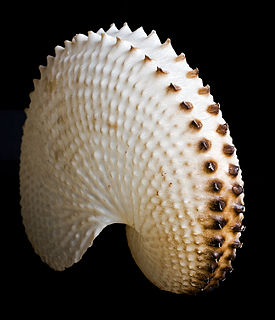 W
WThe Argonautidae are a family of pelagic cephalopods that inhabit tropical and temperate oceans of the world. The family encompasses the modern paper nautiluses of the genus Argonauta along with several extinct genera of shelled octopods. Though argonauts are derived from benthic octopuses, they have evolved to depart the sea floor and live their life-cycle in the open seas.
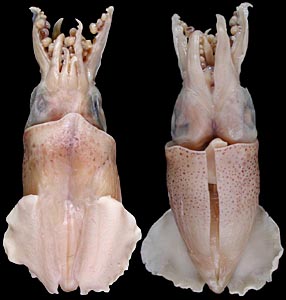 W
WAustraliteuthis aldrichi is a small species of squid from northern Australian waters. It was described by Chung Cheng Lu in 2005 based on specimens collected in inshore waters of Northern Australia. The largest known individual of this species is a mature female measuring 27.6 mm in mantle length (ML). The holotype is a mature male of 21.3 mm ML. A. aldrichi has never been seen alive. It is the only member of the genus Australiteuthis and the family Australiteuthidae.
 W
WThe Bolitaeninae are a subfamily, in the family Amphitretidae, of small, common pelagic octopuses found in all tropical and temperate oceans of the world. The taxonomy of this taxon is not entirely certain; recent research suggests just two genera exist, Bolitaena and Japetella, both of which are thought to be monotypic by some authorities and under this view, the family would represent two very similar species: Bolitaena pygmaea and Japetella diaphana. However, currently a second species of Bolitaena, B. massyae is also recognised.
 W
WCirroteuthidae is a family of cirrate octopuses comprising three species in two genera.
 W
WThe Enoploteuthidea are a family of squid comprising approximately 40 species in four genera. Most species have a mantle length ranging from 3–13 cm. Hooks are present on all arms and tentacles. The family is best known for the large array of photophores throughout the body.
 W
WEnteroctopodidae is a small family of octopuses. This family was formerly considered a subfamily of the family Octopodidae sensu lato but this family has now been divided into a number of separate families with Enteroctopodidae as one of them.
 W
WThe Estonioceratidae are a family of loosely coiled tarphycerids in which the inner side of the whorls, which forms the dorsum, is rounded or flat with no impression, and in which the siphuncle, composed of thick tubular segments, is located ventrally. The Estonioceratidae seem to form a link between the ancestral Bassleroceratidae and the more tightly coiled Tarphyceratidae.
 W
WThe Gonatidae, also known as armhook squid, are a family of moderately sized squid. The family contains about 19 species in three genera, widely distributed and plentiful in cold boreal waters of the Pacific Ocean. At least one species is known from Antarctic waters, and two from the North Atlantic. The genus Eogonatus was created for the species known as Eogonatus tinro because it did not have hooks on the tentacular club and it has 5 rows of teeth on the radula. Molecular studies in allozymes and mitochondrial DNA have indicated that this species nests within the genus Gonatus, although other authorities treat it as a synonym of Gonatopsis okutanii.
 W
WHistioteuthidae is a family of Oegopsid squid. The family was previously considered to be monotypic but the World Register of Marine Species assigns two genera to this family.
 W
WLechritrochoceratidae is a family of derived tarphycerids from the middle and upper Silurian, once included in the now largely abandoned Barrandeocerida.
 W
WLoliginidae, commonly known as pencil squids, is an aquatic family of squid classified in the order Myopsida.
 W
WThe Lycoteuthidae are a family of squid comprising four known genera in two subfamilies. They are small muscular squid characterised by a lack of hooks and by photophores present on the viscera, eyeballs and tentacles. They inhabit tropical and subtropical seas where the diel migrants which stay down in the mesopelagic zone during the day and migrate to the surface to feed at night. Some species show strong sexual dimorphism.
 W
WThe Mastigoteuthidae, also known as whip-lash squid, are a family of small deep-sea squid. Approximately 20 known species in six genera are represented, with members found in both the mesopelagic and bathypelagic zone of most oceans. Originally described by Verill in 1881, it was later lowered by Chun (1920) to a subfamily (Mastigoteuthinae) of the Chiroteuthidae. However, Roper et al. (1969) raised it back to the family level, and this has not been changed since. The taxonomy of this family is extremely unstable, and there have been at times one genus, two genera and four subgenera(Salcedo-Vargas & Okutani, 1994), two genera and several 'groups', five genera and one species with an uncertain placement, or six genera.
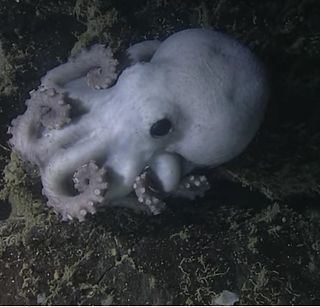 W
WMegaleledonidae is a family of octopuses in the superfamily Octopodoidea. It was formerly placed in the family Octopodidae sensu lato as the subfamily Megaleledoninae but more recent studies have raised this taxon as a valid family.
 W
WThe Octopodidae comprise the family containing the majority of known octopus species.
 W
WThe Octopoteuthidae are a family of squid comprising two genera. The family is characterised by tentacles which cease to grow after the paralarval stage, and the use of a penis, instead of a hectocotylus.
 W
WOmmastrephidae is a family of squid containing three subfamilies, 11 genera, and over 20 species. They are widely distributed globally and are extensively fished for food. One species, Todarodes pacificus, comprises around half of the world's cephalopod catch annually.
 W
WThe hooked squid, family Onychoteuthidae, currently comprise about 20–25 species, in six or seven genera. They range in mature mantle length from 7 cm to a suggested length of 2 m for the largest member, Onykia robusta. The family is characterised by the presence of hooks only on the tentacular clubs, a simple, straight, funnel–mantle locking apparatus, and a 'step' inside the jaw angle of the lower beak. With the exception of the Arctic Ocean, the family is found worldwide.
 W
WUmbrella octopuses are a group of pelagic octopuses. Umbrella octopuses are characterized by a web of skin between the tentacles, causing them to somewhat resemble an opened umbrella when the tentacles are spread.
 W
WThe Phragmoceratidae is a family of extinct nautiloid cephalopods from the Order Discosorida that lived during the latter part of the Silurian.
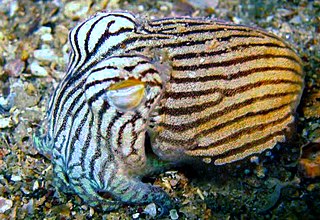 W
WSepiadariidae is a family of cuttlefish, cephalopods in the order Sepiida.
 W
WSepiidae is a family of cephalopods in the order Sepiida.
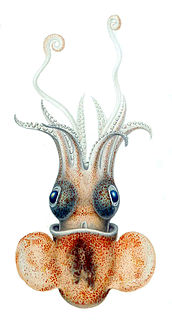 W
WSepiolidae is a family of bobtail squid encompassing 15 genera in three or four subfamilies.
 W
WVampyroteuthidae is a family of vampyromorph cephalopods comprising the extant vampire squid, Vampyroteuthis infernalis, and the extinct Vampyronassa rhodanica from the Middle Jurassic.